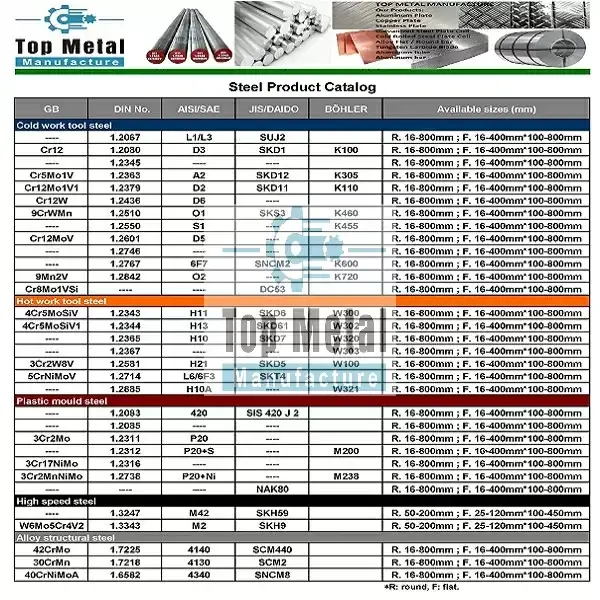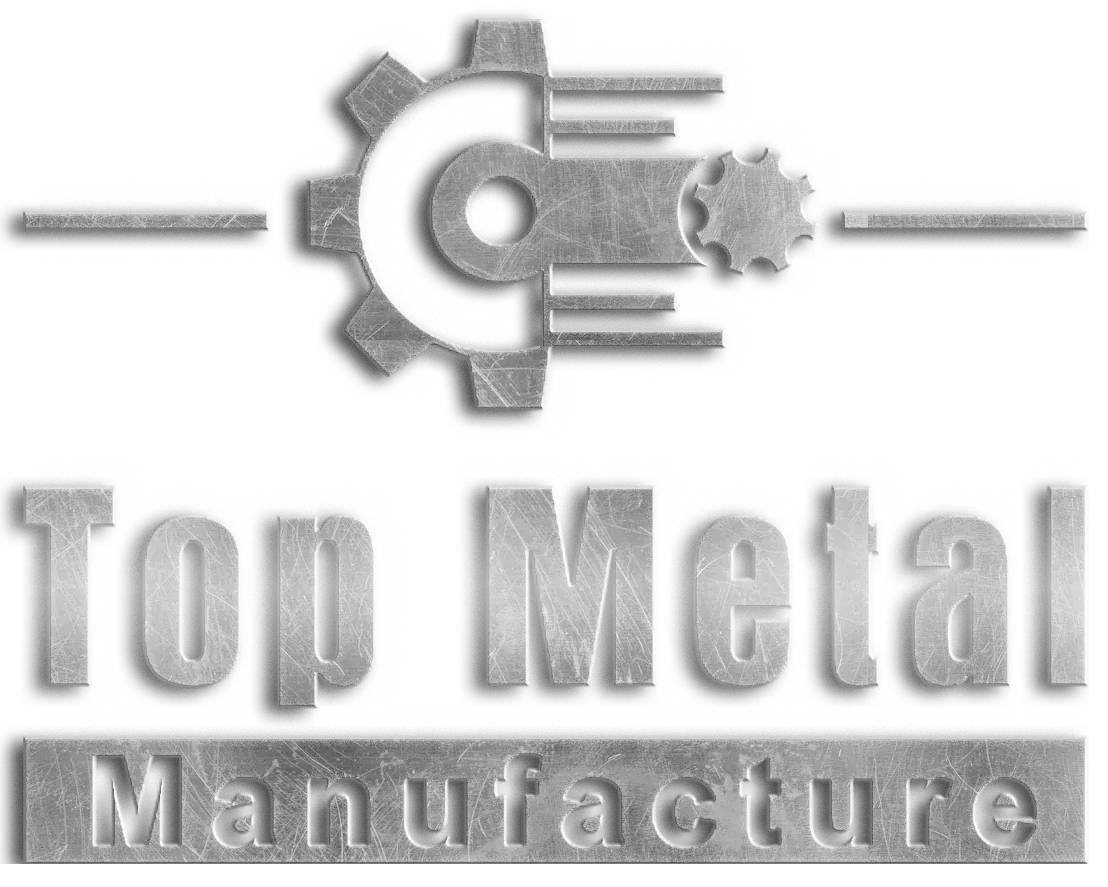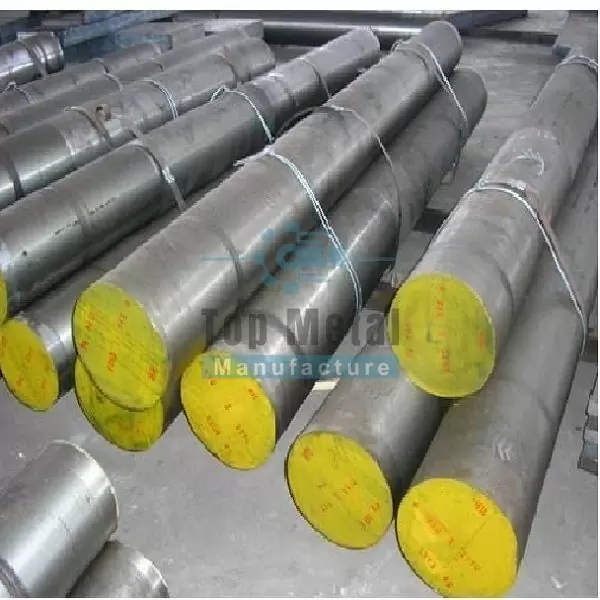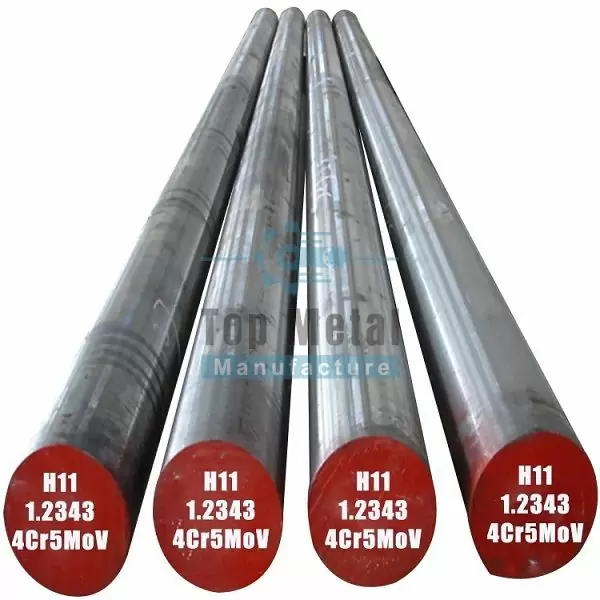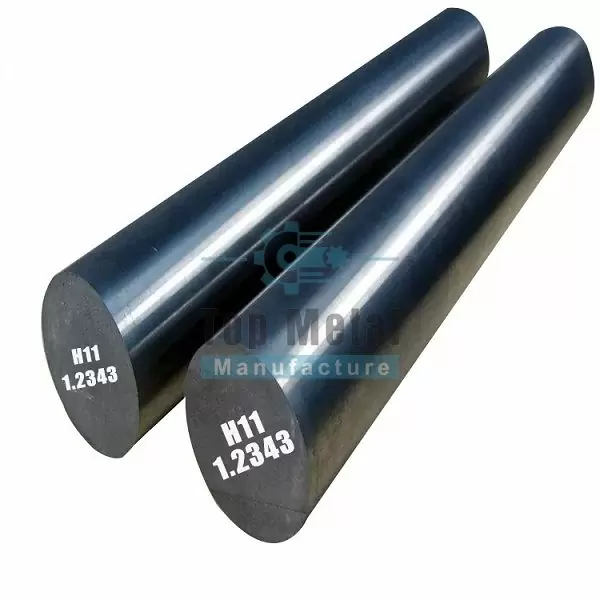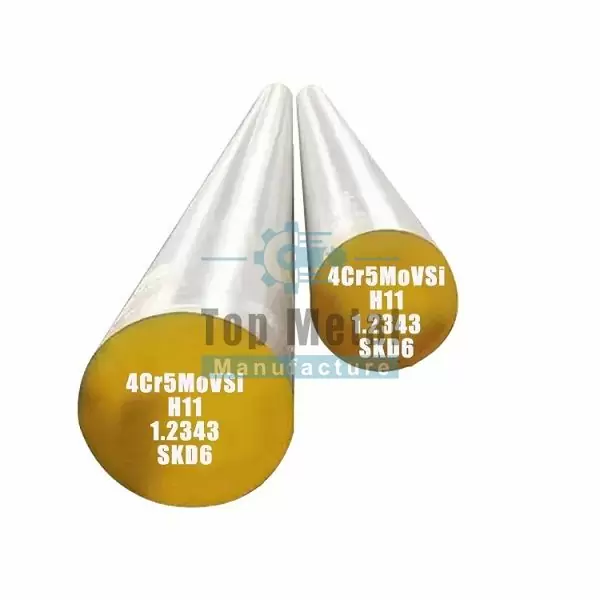Werkzeugstahl H11 weist dank seines ausgewogenen Legierungsgehalts einen minimalen Verzug beim Tiefhärten und Lufthärten auf. H11 kann auch mit einem Luftabschreckverfahren gehärtet werden.
Werkzeugstahl H11, entsprechend 882, ist ein 5% Chrom-Warmarbeitsstahl, der speziell für Anwendungen entwickelt wurde, die extreme Zähigkeit in Kombination mit hoher Warmhärte erfordern. Er bietet zusätzliche Sicherheit bei Werkzeugen, die starken Hammerschlägen ausgesetzt sind, sowie bei Werkzeugen mit tiefen Aussparungen oder scharfen Kanten.
Werkzeugstahl H11 wird bei 900–1120 °C geschmiedet. Bei Temperaturen unter 900 °C ist ein erneutes Erwärmen erforderlich. AISI H11-Stahl sollte im Ofen möglichst langsam abgekühlt werden. Nach dem Schmieden wird ein Glühen empfohlen. Das Spannungsarmglühen zum Abbau von Bearbeitungsspannungen erfolgt durch Erhitzen auf 650 °C, eine Stunde Halten bei dieser Hitze und anschließendes Abkühlen im Ofen.
Werkzeugstahl H11 Äquivalente Qualität: AISI H11, SAE H11, H11, 4Cr5MoSiV, DIN 1.2343, JIS SKD6, DAIDO SKD6 BOHLER W300
| Material | 1.2343 (Chemische Zusammensetzungen %) | |||||||
| C Si Mn Cr Mo VP & S | ||||||||
| 0,36–0,42 0,90–1,20 0,30–0,50 4,80–5,80 1,10–1,40 0,25–0,50 ≤0,030 | ||||||||
| Größe | Rund φ20-650mm; Flach 20-450×50-810mm | |||||||
| Ursprungsort | In China hergestellt | |||||||
| Lieferbedingungen | Geschmiedet/warmgewalzt | |||||||
| Oberflächenbehandlung | Schwarz/geschliffen/geschält/gedreht/gefräst/poliert/glänzend | |||||||
| Wärmebehandlung | 2-4 mal geglüht | |||||||
| Verpackung | Seetaugliche Verpackung oder nach Kundenwunsch | |||||||
| Mindestbestellmenge | 10 Tonnen | |||||||
| Lieferzeit | 60 Tage | |||||||
| Handelsbegriff | FOB/CIF/CFR | |||||||
| Zahlungsbedingung | T/T | |||||||
| Ladehafen | Shanghai | |||||||
Die Umformeigenschaften von H-11 H11 AMS 6487 Werkzeugstahl sind im Vergleich zu herkömmlichen Methoden gut. Es kann auch durch Schmieden und Bearbeiten geformt werden. Schweißen H-11 AMS 6487 Werkzeugstahl ist eine mit herkömmlichen Methoden leicht handhabbare Legierung.
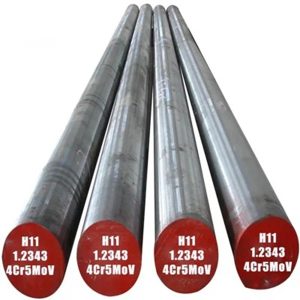
| Warmarbeitsstahl | |
| LÄRM | 1.2344,1.2343,1.2365,1.2581,1.2367,1.2714 usw. |
| AISI | H13, H11, H10, H21, L6 usw. |
| JIS | SKD61, SKD6, SKD5, SKT4 usw. |
| Kaltarbeit zu Stahl | |
| LÄRM | 1.2601,1.2379,1.2080,1.2363,1.2842,1.2419,1.2510,1.2550,1.2767 usw. |
| AISI | D2, D3, A2, O2, O1 usw. |
| JIS | SKD1, SKD11, STD12, SKS31, SKS3 usw. |
| Kunststoffformstahl | |
| LÄRM | 1.2083,1.2311,1.2312,1.2316,1.2738 usw. |
| AISI | P20, P20+Ni, P20+S,420 usw. |
| JIS | NAK80 |
WERKZEUGSTAHL DER GÜTE H11, ein Mitglied der Familie der Warmarbeitsstähle, hat sich aufgrund seiner außergewöhnlichen Eigenschaften in verschiedenen industriellen Anwendungen eine Nische geschaffen.
1. Chemische Zusammensetzung
Werkzeugstahl H11 zeichnet sich durch eine ausgewogene chemische Zusammensetzung aus. Er enthält einen moderaten Kohlenstoffanteil, typischerweise etwa 0,33 – 0,43%. Kohlenstoff ist entscheidend, da er zur Härte und Festigkeit des Stahls beiträgt. Durch sorgfältige Kontrolle des Kohlenstoffgehalts erreicht H11 ein ausgewogenes Verhältnis zwischen Verschleißfestigkeit und Zähigkeit.
Chrom (Cr) ist in H11 in einer Konzentration von etwa 4,75 – 5,50% enthalten. Chrom verbessert die Härtbarkeit, Korrosionsbeständigkeit und Hochtemperaturfestigkeit des Stahls erheblich. Bei der Wärmebehandlung bildet es Karbidverbindungen, die eine wichtige Rolle bei der Stärkung der Mikrostruktur des Stahls spielen.
Molybdän (Mo) ist ein weiteres wichtiges Legierungselement in H11 mit einem Gehalt von etwa 1,10 – 1,75%. Molybdän verbessert die Härtbarkeit, Kriechfestigkeit und Anlasserweichungsbeständigkeit des Stahls. Es trägt außerdem dazu bei, die kritische Abkühlrate beim Abschrecken zu reduzieren, was zur Vermeidung von Rissen und Verformungen beiträgt.
Vanadium (V) wird in geringen Mengen von etwa 0,30 – 0,60% zugesetzt. Vanadium bildet feine Karbidpartikel, die extrem hart und stabil sind. Diese Karbide erhöhen die Verschleißfestigkeit und Zähigkeit von H11 und tragen dazu bei, dass es seine Härte auch bei hohen Temperaturen behält.
2. Mechanische Eigenschaften
Werkzeugstahl H11 weist hervorragende mechanische Eigenschaften auf, die ihn für anspruchsvolle Anwendungen geeignet machen. Seine Härte kann nach entsprechender Wärmebehandlung einen Rockwell-C-Wert (HRC) von etwa 50–55 erreichen. Diese hohe Härte macht den Stahl verschleiß- und verformungsbeständig und gewährleistet so eine langlebige Leistung in Anwendungen wie Druckgussformen und Schmiedewerkzeugen.
Auch die Zähigkeit von H11 ist bemerkenswert. Es hält erheblichen Schlagkräften stand, ohne zu brechen, was bei Anwendungen, bei denen das Werkzeug wiederholten Stoßbelastungen ausgesetzt ist, entscheidend ist. Diese Kombination aus Härte und Zähigkeit wird durch die sorgfältige Kontrolle der Legierungselemente und des Wärmebehandlungsprozesses erreicht.
In Bezug auf die Dauerfestigkeit weist H11 eine gute Beständigkeit gegen zyklische Belastungen auf. Diese Eigenschaft ist für Werkzeuge mit hoher Zyklusbelastung unerlässlich, da sie dazu beiträgt, vorzeitigen Ausfall durch Ermüdungsrisse zu verhindern.
3. Wärmebehandlung
Die Wärmebehandlung ist ein entscheidender Prozess, damit H11 seine optimalen Eigenschaften erreicht. Der typische Wärmebehandlungsprozess für H11 umfasst Glühen, Abschrecken und Anlassen.
Das Glühen erfolgt bei etwa 845–870 °C, gefolgt von einer langsamen Abkühlung. Dieser Prozess macht den Stahl weicher, baut innere Spannungen ab und verbessert die Bearbeitbarkeit. Außerdem verfeinert er die Kornstruktur und bereitet den Stahl auf nachfolgende Wärmebehandlungen vor.
Das Abschrecken erfolgt üblicherweise bei hohen Temperaturen von etwa 1010 bis 1050 °C, gefolgt von einer schnellen Abkühlung, häufig in Öl oder einem geeigneten Abschreckmedium. Dieses Abschrecken bei hohen Temperaturen ist notwendig, um durch die Umwandlung der Mikrostruktur in eine martensitische Phase die gewünschte Härte und Festigkeit zu erreichen.
Das Anlassen erfolgt anschließend bei Temperaturen zwischen 550 und 650 °C. Das Anlassen trägt dazu bei, die beim Abschrecken entstandenen inneren Spannungen abzubauen, die Zähigkeit des Stahls zu verbessern und die Härte auf das gewünschte Niveau zu bringen. Mehrere Anlasszyklen können durchgeführt werden, um die Eigenschaften von H11 weiter zu optimieren.
4. Bewerbungen
Aufgrund seiner hervorragenden Eigenschaften findet H11 breite Anwendung in der verarbeitenden Industrie. In der Druckgussindustrie, Werkzeugstahl H11 wird häufig zur Herstellung von Gussformen für Nichteisenmetalle wie Aluminium und Magnesium verwendet. Dank der hohen Temperaturfestigkeit und Verschleißfestigkeit von H11 halten die Gussformen den harten Bedingungen des Druckgussprozesses stand, einschließlich hohem Druck und wiederholtem Kontakt mit geschmolzenem Metall.
In der Schmiedeindustrie wird H11 zur Herstellung von Schmiedegesenken verwendet. Diese Gesenke müssen eine hohe Festigkeit, Zähigkeit und Verschleißfestigkeit aufweisen, um warmverformte Metalle in die gewünschte Form zu bringen. Die Fähigkeit von H11, seine Eigenschaften auch bei hohen Temperaturen beizubehalten, macht es zur idealen Wahl für diese Anwendung.
Es wird auch bei der Herstellung von Extrusionswerkzeugen verwendet, bei denen der Stahl den hohen Kräften und Temperaturen standhalten muss, die beim Durchdrücken des Metalls durch eine Düse zur Herstellung verschiedener Formen entstehen. Darüber hinaus findet sich H11 in einigen Kunststoffspritzgussformen, insbesondere für Hochtemperaturkunststoffe oder in Anwendungen, bei denen langfristige Verschleißfestigkeit erforderlich ist.
Andere Werkzeugstahlmaterialien verfügbar
